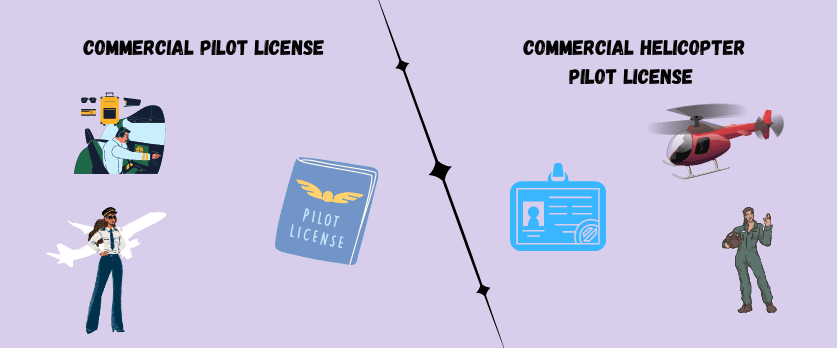The main difference between a Commercial Pilot License (CPL) and a Commercial Helicopter Pilot License (CHPL) lies in the type of aircraft they allow the pilot to operate. Here are the key distinctions:
Type of Aircraft
Commercial Pilot License (CPL)
This license allows the holder to operate fixed-wing aircraft, such as airplanes. It is not specific to any particular category or class of airplane, so a pilot with a CPL can fly various types of airplanes, including single-engine and multi-engine aircraft.
Commercial Helicopter Pilot License (CHPL)
This license is specific to helicopter operations. It permits the pilot to operate helicopters for commercial purposes.
Training Requirements
The training requirements for CPL and CHPL differ based on the type of aircraft. Both licenses require a certain number of flight hours, including both solo and dual instruction time, but the specific requirements can vary.
Flight Tests
The flight test for CPL and CHPL is tailored to the type of aircraft. A CPL applicant for airplanes will undergo a flight test in an airplane, while a CHPL applicant will have a flight test in a helicopter.
Ground School
Ground school training covers a range of subjects, including navigation, meteorology, aerodynamics, regulations, and more. While there are common elements between CPL and CHPL ground school, the specific content may be tailored to the type of aircraft.
Career Opportunities
Holders of a CPL for airplanes may pursue careers as commercial airline pilots, charter pilots, or other fixed-wing aircraft-related roles.
Holders of a CHPL typically pursue careers in helicopter-related fields, such as helicopter tours, emergency medical services (EMS), search and rescue, offshore oil rig transport, and more.
In summary, the primary difference lies in the type of aircraft that each license allows the pilot to operate. The training, skills, and knowledge required are tailored to either fixed-wing (CPL) or helicopter (CHPL) operations. Pilots often choose the license that aligns with their career goals and the type of flying they enjoy.
FAQs
Q1. What is a Commercial Pilot License (CPL)?
A. A CPL is a professional pilot license that allows individuals to act as pilots for compensation or hire in the operation of aircraft.
Q2. What is a Commercial Helicopter Pilot License (CHPL)?
A. A CHPL is a similar license but specifically for helicopter operations, allowing individuals to fly helicopters for commercial purposes.
Q3. What are the basic requirements for obtaining a CPL?
A. Requirements typically include a minimum number of flight hours, both solo and dual instruction, completion of ground school, and passing a flight test.
Q4. How does the CHPL differ from the CPL in terms of aircraft type?
A. A CPL allows pilots to operate fixed-wing aircraft, while a CHPL is specific to helicopter operations.
Q5. What types of jobs can I pursue with a CPL for airplanes?
A. Career options include becoming a commercial airline pilot, charter pilot, or working in various fixed-wing aircraft-related roles.
Q6. What career opportunities are available for CHPL holders?
A. CHPL holders often pursue careers in helicopter-related fields, such as tours, emergency medical services (EMS), search and rescue, and offshore transport.
Q7. What is the duration of training for a CPL or CHPL?
A. Training duration can vary, but it typically takes several months to complete the required flight hours and ground school.
Q8. Can I use my CPL or CHPL in other countries?
A. Aviation authorities often have bilateral agreements, allowing the validation or conversion of licenses between countries, but specific requirements may vary.
Q9. Is there a maximum age limit for obtaining a CPL or CHPL?
A. There is no strict maximum age limit, but the applicant must meet medical and proficiency requirements.
Q10. What medical requirements must I fulfill for CPL or CHPL?
A. Applicants must pass a class-specific medical examination conducted by an aviation medical examiner.
Q11. Can I apply for a CPL or CHPL with only simulator hours?
A. While simulator hours may count toward certain requirements, a significant portion of the flight hours must be acquired in actual aircraft.
Q12. Are there specific written exams for CPL and CHPL?
A. Yes, applicants must pass written exams covering various subjects such as navigation, meteorology, regulations, and aerodynamics.
Q13. Can I become a commercial pilot if I wear glasses or contact lenses?
A. Vision requirements vary, but correctable vision is generally acceptable. Applicants should meet the vision standards outlined by aviation authorities.
Q14. What is the difference between CPL and an Airline Transport Pilot License (ATPL)?
A. An ATPL is a higher-level license that allows a pilot to serve as the pilot-in-command of an aircraft in commercial air transport. CPL is a prerequisite for obtaining an ATPL.
Q15. Can I upgrade from a CPL to a CHPL or vice versa?
A. While there may be some common elements, converting from one to the other typically involves additional training and testing specific to the aircraft type.
For more details and the admission process, click the links for comprehensive information on Commercial Pilot License and AMECEE Exam.
To become an commercial pilot you may could join commercial pilot license through AME COMMON ENTRANCE EXAM (AME CEE) this examination you may join Commercial Pilot License approved by DGCA.


